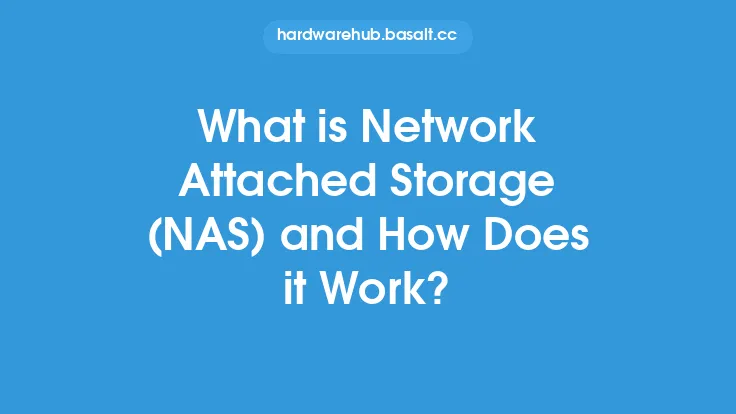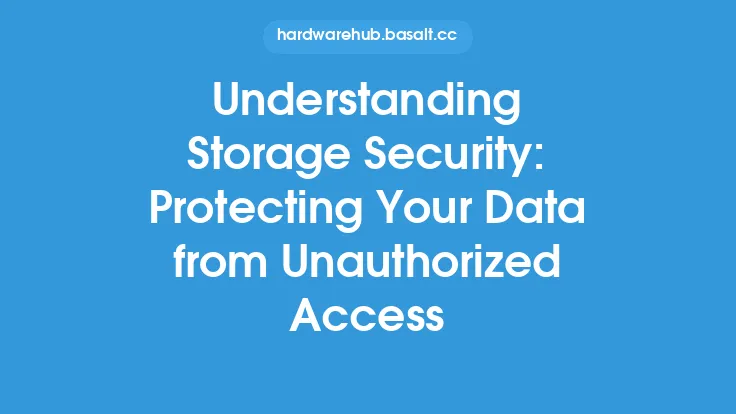The security of storage systems is a critical concern for organizations and individuals alike, as the loss or compromise of sensitive data can have severe consequences. Storage security threats can come in many forms, including physical, network-based, and software-based attacks. In this article, we will explore the common risks associated with storage security and discuss ways to mitigate them.
Introduction to Storage Security Threats
Storage security threats can be broadly categorized into several types, including unauthorized access, data breaches, malware and ransomware attacks, and physical damage to storage devices. Unauthorized access occurs when an individual or entity gains access to sensitive data without permission, often through exploiting vulnerabilities in the storage system or using stolen credentials. Data breaches, on the other hand, involve the unauthorized release of sensitive data, which can be caused by a variety of factors, including hacking, insider threats, and physical theft of storage devices. Malware and ransomware attacks involve the use of malicious software to compromise or encrypt data, often for the purpose of extorting money from the victim. Physical damage to storage devices can also compromise the security of stored data, particularly if the devices are not properly protected against environmental hazards such as fire, water, and extreme temperatures.
Common Storage Security Risks
Several common storage security risks can compromise the security of stored data. One of the most significant risks is the use of weak passwords or authentication protocols, which can allow unauthorized individuals to gain access to sensitive data. Another risk is the lack of encryption, which can leave data vulnerable to interception or eavesdropping. Additionally, the use of outdated or unpatched storage software can create vulnerabilities that can be exploited by attackers. Insufficient access controls, such as the failure to implement role-based access control or to restrict access to sensitive data, can also compromise storage security. Furthermore, the lack of monitoring and incident response planning can make it difficult to detect and respond to storage security incidents in a timely and effective manner.
Network-Based Storage Security Threats
Network-based storage security threats are a significant concern, particularly in environments where storage devices are connected to the internet or other networks. One of the most common network-based threats is the use of malware and ransomware, which can spread through networks and compromise storage devices. Another threat is the use of phishing and social engineering attacks, which can trick individuals into revealing sensitive information or gaining access to storage devices. Additionally, the use of unsecured protocols, such as FTP or Telnet, can leave data vulnerable to interception or eavesdropping. To mitigate these threats, it is essential to implement robust network security measures, such as firewalls, intrusion detection and prevention systems, and secure protocols like SSH and HTTPS.
Software-Based Storage Security Threats
Software-based storage security threats can also compromise the security of stored data. One of the most significant threats is the use of vulnerabilities in storage software, which can be exploited by attackers to gain access to sensitive data. Another threat is the use of malicious software, such as Trojans or spyware, which can compromise storage devices and steal sensitive information. Additionally, the use of unpatched or outdated storage software can create vulnerabilities that can be exploited by attackers. To mitigate these threats, it is essential to keep storage software up to date, implement robust patch management processes, and use anti-virus and anti-malware software to detect and remove malicious software.
Physical Storage Security Threats
Physical storage security threats can also compromise the security of stored data, particularly in environments where storage devices are not properly protected against environmental hazards. One of the most significant threats is the risk of physical damage to storage devices, which can be caused by factors such as fire, water, and extreme temperatures. Another threat is the risk of theft or loss of storage devices, which can result in the unauthorized release of sensitive data. Additionally, the use of insecure storage facilities, such as unsecured data centers or storage rooms, can compromise the security of stored data. To mitigate these threats, it is essential to implement robust physical security measures, such as access controls, surveillance cameras, and environmental controls, to protect storage devices against environmental hazards and unauthorized access.
Mitigating Storage Security Threats
To mitigate storage security threats, it is essential to implement a comprehensive storage security strategy that includes several key elements. One of the most critical elements is the use of encryption, which can protect data against unauthorized access or interception. Another element is the implementation of robust access controls, such as role-based access control and multi-factor authentication, to restrict access to sensitive data. Additionally, the use of secure protocols, such as SSH and HTTPS, can protect data against interception or eavesdropping. It is also essential to keep storage software up to date, implement robust patch management processes, and use anti-virus and anti-malware software to detect and remove malicious software. Furthermore, the implementation of monitoring and incident response planning can help detect and respond to storage security incidents in a timely and effective manner.
Best Practices for Storage Security
Several best practices can help ensure the security of stored data. One of the most critical best practices is the use of a defense-in-depth approach, which involves implementing multiple layers of security controls to protect against various types of threats. Another best practice is the implementation of a robust access control framework, which includes role-based access control, multi-factor authentication, and segregation of duties. Additionally, the use of encryption and secure protocols can protect data against unauthorized access or interception. It is also essential to keep storage software up to date, implement robust patch management processes, and use anti-virus and anti-malware software to detect and remove malicious software. Furthermore, the implementation of monitoring and incident response planning can help detect and respond to storage security incidents in a timely and effective manner.
Conclusion
In conclusion, storage security threats are a significant concern, and it is essential to implement a comprehensive storage security strategy to protect against various types of threats. By understanding the common risks associated with storage security and implementing best practices, such as the use of encryption, access controls, and secure protocols, organizations and individuals can help ensure the security of stored data. Additionally, the implementation of monitoring and incident response planning can help detect and respond to storage security incidents in a timely and effective manner. By taking a proactive approach to storage security, organizations and individuals can help protect against the ever-evolving landscape of storage security threats and ensure the confidentiality, integrity, and availability of sensitive data.





